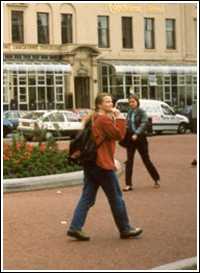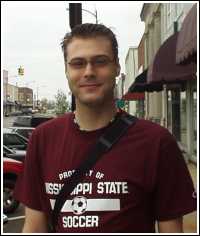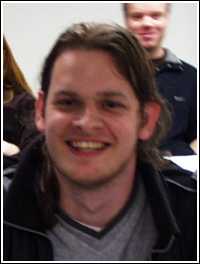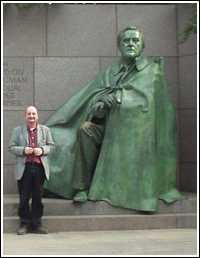FRtR > Information > About the project
About the project
The years 1996-2003
Since februari 1996 quite a lot has changed. In 1997 Garry Wiersema redesigned the whole style of the project and brought in something new: consistency. For the first time we tried to set up a structured plan for the project, which would facilitate working on it with groups of students with varying skills in HTML. The whole project was subdivided in a number of sub-hypertexts, which would all have a different recognisable style. For example, all pages regarding the presidents of the United States would have a band on the left side in the color presidential blue, the essays would have a yellow band, the biographies a green band, gray for the information about the project etc. For all the parts we prepared templates, which would make it easy for students to work with.
Next to that, a very rigid structure was designed, which would could grow with the growth of the project, without losing track where all the diferent files would be. Actually, we are still sticking to that structure, be it in a slightly modified way.
 Garry Wiersema and I worked like maniacs to get the whole conversion to the new layout ready for the AHC-conference in Glasgow, where Garry explained the ins and outs of the new design. The reactions were good and we were mighty pleased with ourselves. The new design brought consistency of form and was very recognisable. Nevertheless, after working with it for a couple of years and learning a bit about design, some serious flaws of the design became apparent to me.
Garry Wiersema and I worked like maniacs to get the whole conversion to the new layout ready for the AHC-conference in Glasgow, where Garry explained the ins and outs of the new design. The reactions were good and we were mighty pleased with ourselves. The new design brought consistency of form and was very recognisable. Nevertheless, after working with it for a couple of years and learning a bit about design, some serious flaws of the design became apparent to me.
Allthough we had tried to enrich texts by adding hyperlinks, still the whole project looked like something converted from paper to the screen. We had not yet realised that designing for the screen is something completely different than designing for paper. Some of the decisions we had made were good: we had agreed not to use frames in the design to make it easier for the users to make bookmarks where ever they wanted, without being transported back to the homepage every time. We had split up larger texts into smaller chunks etc. But there were other things we had completely overlooked.
After discussions with prof. Paula Petrik about web-design and after reading Jakob Nielsen and Edward Tufte, it was clear to me that there was room for improvement. We had chosen th Times New Roman as our main font: that is a serif font, that looks pretty smart on paper, but in spite of what Tufte says: it does not work well on screen. The screen resolution just is not good enough to use such a dense font. Suggestions made by prof. Petrik made us decide to change our main font to the Verdana: a sans-serif font, which works very well on screen. Since this is a project that relies heavily on reading text from screen, I am still in doubt if the choice is correct. A less dense serif font like f.e. the Garamond might work better, since there are indications that people read text in serif-fonts faster - at least from paper - than sans-serif fonts. There is a chance we will do some experiments in that respect in the near future.
But, to be able to control the lay-out much better, we had to switch from hard-coded HTML to Cascading Stylesheets and Javascripts. We might even take it further: make a complete seperation between the texts and the lay-out, generating the pages on the fly from a database, in which the texts would bestored. There is only one good reason not to do this: I still use this project with students who are learning the basics of web-design and HTML. CSS and a passive understanding of JavaScript are achievable goals for such groups in a 7 week course, but adding to web-design having to understand the ins and outs of databases and accessing them from the web is something else.
That change was not so simple: there are about 4000 HTML-files in this project and they have all been made by different people in various countries on different editors and platforms, and we learned very quickly that simple search-and-replace programs would not do the trick. So I asked my assistant at that time - Peter Scholing - to make some prototypes for new designs. After lengthy discussions we decided for the design we are using now, which is based on a combination of cascading stylesheets, javascript and hard coded HTML. We try to restrict the hard-coded HTML to the logic mark up, and keep the lay-out mark-up in the stylesheets. JavaScripts are used to program repetitive structeres and hand some other things.
 Under the supervision of Peter Scholing, ten students did the Herculean job of converting the old version to the new version. Due to circumstances, I was not available at that time to supervise it all and Peter, being a student himself, could not put as much pressure on his fellow students as a teacher could have done. So, in the end the work was done, but not completely flawless. My next assistant, Fokke van der Molen, went through the whole project to make the necessary corrections, replace an old JavaScript by an improved form of the same script etc.: very much tedious work. At the end of 2002 we changed some names of directories on the server, and low and behold, the new version was working on the main server. We were confident that everything would out fine, since we had tested it on the mirror-server. The mirror-server is running on a windows-platform and the main-server is running on a unix-platform, and as some of you know, that can make some nasty little differences. And like always, Murphy's law began operating: things went wrong. But not everywhere and not very systematically. The result is, that we find small errors every once in a while and sometimes people point them out to us and we correct them.
Under the supervision of Peter Scholing, ten students did the Herculean job of converting the old version to the new version. Due to circumstances, I was not available at that time to supervise it all and Peter, being a student himself, could not put as much pressure on his fellow students as a teacher could have done. So, in the end the work was done, but not completely flawless. My next assistant, Fokke van der Molen, went through the whole project to make the necessary corrections, replace an old JavaScript by an improved form of the same script etc.: very much tedious work. At the end of 2002 we changed some names of directories on the server, and low and behold, the new version was working on the main server. We were confident that everything would out fine, since we had tested it on the mirror-server. The mirror-server is running on a windows-platform and the main-server is running on a unix-platform, and as some of you know, that can make some nasty little differences. And like always, Murphy's law began operating: things went wrong. But not everywhere and not very systematically. The result is, that we find small errors every once in a while and sometimes people point them out to us and we correct them.
But all in all, it works. It is sad that we had to say goodbye to our mascotte "Sammy the All American Eagle", but he is still on the t-shirts of the project. We do not think that the new design is ideal, but it works for a text-based project like this. What are the most important changes?
- The new menu-design, which is on the left-side and no longer on the top: the menu is partly a text-based form, which allows it to load faster compared to the old menu based on a GIF, with a map. Although left-sided menu's - according to Jakob Nielson - are a "style error", they have become the standard on the web.
- The new logo also functons as a "home" button: clicking the logo will always bring you back to the home-page
- The search-engine is available on every page: we are not completely happy with the search-engine,but attempts at making our own have not been very successful
- We have added a trace of the last pages you have visited, to improve the navigation facilities
- Our new main font is the Verdana instead of the old Times New Roman.
- The length of text-lines has been reduced to 540 pixels to improve ease of reading.
- Texts are now "fully justified", which makes them easier to read also
- The use of "underline" and "italics" has been replaced by using different colors: underline and italics do not work very well on screen. At the moment we have chosen the following colors:
- Italics - green
- Emphasis - brown
- Strong - blue
- Underline - magenta
Maybe these choices will change in the future, depending on the reactions.
Illustrations
 We started this project in 1994 and at that moment it was very hard to find any good historical images on the web. Search-engines that would find them for you were not even made yet. Everyone was also quite paranoid about copyrights and we surely did not want our Alma Mater to get in trouble because of a project like this by infringing copyrights. Our solution was scanning used stamps, that had historical topics on them. It looked nice, but did not improve our academic credibility
We started this project in 1994 and at that moment it was very hard to find any good historical images on the web. Search-engines that would find them for you were not even made yet. Everyone was also quite paranoid about copyrights and we surely did not want our Alma Mater to get in trouble because of a project like this by infringing copyrights. Our solution was scanning used stamps, that had historical topics on them. It looked nice, but did not improve our academic credibility
Times have changed. Rules for fair-use and copyrights have changed a little. The problem with the stamps was, that only a tiny portion of historical events are commemorated on stamps. We have now decided to replace all the stamps with more relevant images. All images will be presented in the same way:
- large landscape - width 540 pixels
- small landscape - width 300 pixels
- small portrait - width 200 pixels
The idea is, that this uniformity will create a more harmonious lay-out.
All images will be cropped or reduced to that size and all images will have a border of 2 pixels white and 1 pixel black. All images will have a description in the ALT-attribute, which will become visible when you mouse over it. The borders are chosen to indicate that the illustrations are not part of the original texts: to seperate them from the text, to indicate that they are just illustrations and not essential to the text. They are added by us to make the pages look more attractive.
Allthough some people were very fond of the images of the stamps, it seems better at this time to replace them by using the enormous wealth of high quality images that is available now. Ofcourse, we will also scan some images ourselves as in the case of the Outlines of American History. We have decided to scan the original illustrations from the Outlines. However, this is a job that we are doing at this moment: some parts of the project will have the stamps until we find better illustrations.
Response
From the very start, we have been amazed by the response to this project: we had never expected anything like that. We even opened an e-mail account for the project, but due to over-spamming our system owner advised us to close it down. The users can still react to the project in the Guestbook, but we reserve the right to censor this guestbook. Quite a number of people seem to think that it is funny to put in obsceneties or propaganda for extreme causes: we will not tolerate that and such contributions will be censored. We will also remove any commercial references: we are not allowed - by our university rules - to engage in such things. Those who really want to get in touch with the supervisor of the project will have to search a bit for the address information: it is there, but we do not want to make it too easy, because otherwise we would get flooded again with junkmail.
CD-ROM
From the beginning this project has been used in many schools and we are very pleased with that. We have received a number of awards for our efforts and we are proud of them. Still, not all schools have good internet-connections. Around 1999 we had som many requests to put the project on a CD-ROM, that I asked my intern Marieke van Ophem to see how that would work out.
 Just putting the whole set of files on a CD-ROM did not work: some of the references that you make to directories in links, will not work on a stand-alone machine: you will get a list of files and not the index-file that you wanted. So, Marieke did the job to make everything compatible for CD-ROMS and wrote a nice flap-text for the CD-ROM. We have been sending them out on request to many schools and home-schoolers. We still hope that some of them will come clear with their conscience, because in many cases we have not received the agreed payment.
Just putting the whole set of files on a CD-ROM did not work: some of the references that you make to directories in links, will not work on a stand-alone machine: you will get a list of files and not the index-file that you wanted. So, Marieke did the job to make everything compatible for CD-ROMS and wrote a nice flap-text for the CD-ROM. We have been sending them out on request to many schools and home-schoolers. We still hope that some of them will come clear with their conscience, because in many cases we have not received the agreed payment.
You can still ask for a CD-ROM version of the project as it is: that means that you cannot complain if some things do not work. We ask a very modest fee to cover our costs: we are a not for profit group. But we cannot keep on sending CD-ROM's all over the world if no one pays for them. If you want one, get intouch with the supervisor.
The Future
Next year the project will celebrate its 10th birthday, but we are sure that it will live quite a bit longer. Every day about 2500 people use this material from the main site or the server. (and from the unauthorized mirror site at a school in the USA, who still has a very old version of the project available) and that number is not declining. We have a very stable group of users and we will be there for quite some time: I think I will pass the torch when I will retire and I still got quite some time to get there.
 Garry Wiersema and I worked like maniacs to get the whole conversion to the new layout ready for the AHC-conference in Glasgow, where Garry explained the ins and outs of the new design. The reactions were good and we were mighty pleased with ourselves. The new design brought consistency of form and was very recognisable. Nevertheless, after working with it for a couple of years and learning a bit about design, some serious flaws of the design became apparent to me.
Garry Wiersema and I worked like maniacs to get the whole conversion to the new layout ready for the AHC-conference in Glasgow, where Garry explained the ins and outs of the new design. The reactions were good and we were mighty pleased with ourselves. The new design brought consistency of form and was very recognisable. Nevertheless, after working with it for a couple of years and learning a bit about design, some serious flaws of the design became apparent to me. Under the supervision of Peter Scholing, ten students did the Herculean job of converting the old version to the new version. Due to circumstances, I was not available at that time to supervise it all and Peter, being a student himself, could not put as much pressure on his fellow students as a teacher could have done. So, in the end the work was done, but not completely flawless. My next assistant, Fokke van der Molen, went through the whole project to make the necessary corrections, replace an old JavaScript by an improved form of the same script etc.: very much tedious work. At the end of 2002 we changed some names of directories on the server, and low and behold, the new version was working on the main server. We were confident that everything would out fine, since we had tested it on the
Under the supervision of Peter Scholing, ten students did the Herculean job of converting the old version to the new version. Due to circumstances, I was not available at that time to supervise it all and Peter, being a student himself, could not put as much pressure on his fellow students as a teacher could have done. So, in the end the work was done, but not completely flawless. My next assistant, Fokke van der Molen, went through the whole project to make the necessary corrections, replace an old JavaScript by an improved form of the same script etc.: very much tedious work. At the end of 2002 we changed some names of directories on the server, and low and behold, the new version was working on the main server. We were confident that everything would out fine, since we had tested it on the  We started this project in 1994 and at that moment it was very hard to find any good historical images on the web. Search-engines that would find them for you were not even made yet. Everyone was also quite paranoid about copyrights and we surely did not want our Alma Mater to get in trouble because of a project like this by infringing copyrights. Our solution was scanning used stamps, that had historical topics on them. It looked nice, but did not improve our academic credibility
We started this project in 1994 and at that moment it was very hard to find any good historical images on the web. Search-engines that would find them for you were not even made yet. Everyone was also quite paranoid about copyrights and we surely did not want our Alma Mater to get in trouble because of a project like this by infringing copyrights. Our solution was scanning used stamps, that had historical topics on them. It looked nice, but did not improve our academic credibility Just putting the whole set of files on a CD-ROM did not work: some of the references that you make to directories in links, will not work on a stand-alone machine: you will get a list of files and not the index-file that you wanted. So, Marieke did the job to make everything compatible for CD-ROMS and wrote a nice flap-text for the CD-ROM. We have been sending them out on request to many schools and home-schoolers. We still hope that some of them will come clear with their conscience, because in many cases we have not received the agreed payment.
Just putting the whole set of files on a CD-ROM did not work: some of the references that you make to directories in links, will not work on a stand-alone machine: you will get a list of files and not the index-file that you wanted. So, Marieke did the job to make everything compatible for CD-ROMS and wrote a nice flap-text for the CD-ROM. We have been sending them out on request to many schools and home-schoolers. We still hope that some of them will come clear with their conscience, because in many cases we have not received the agreed payment.